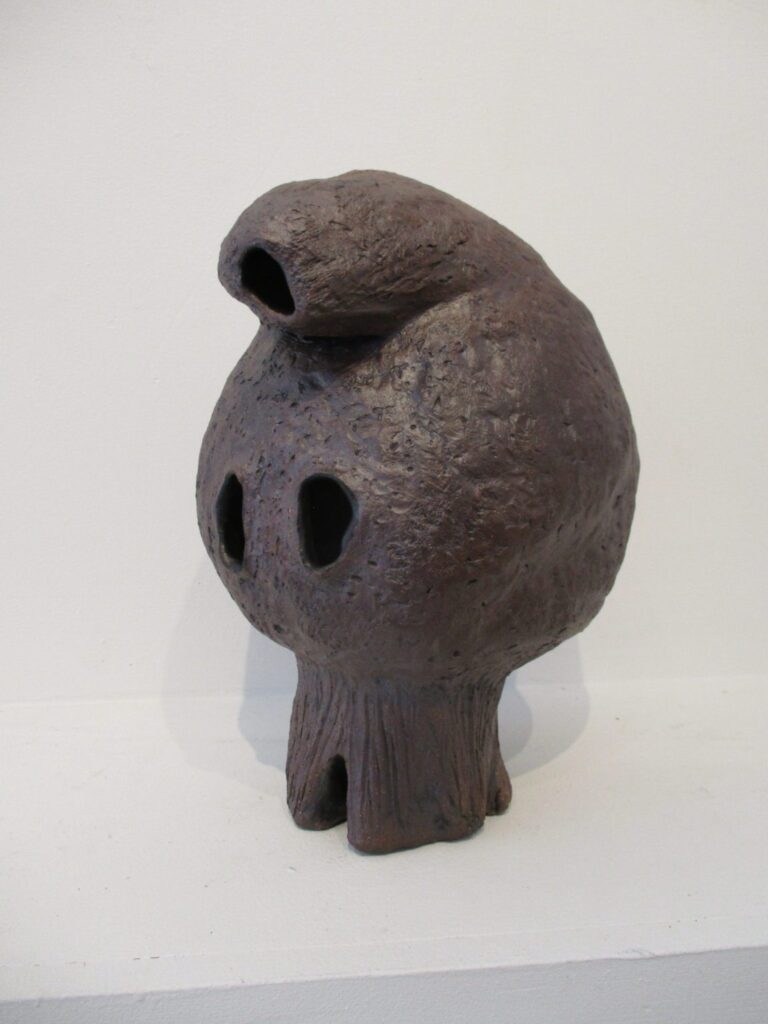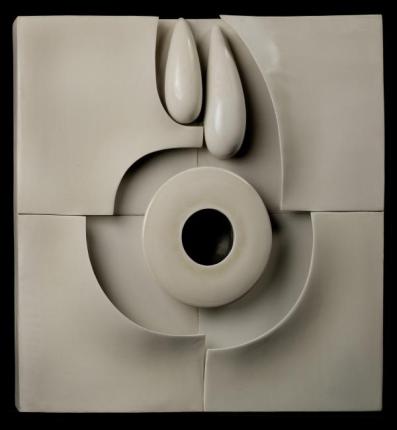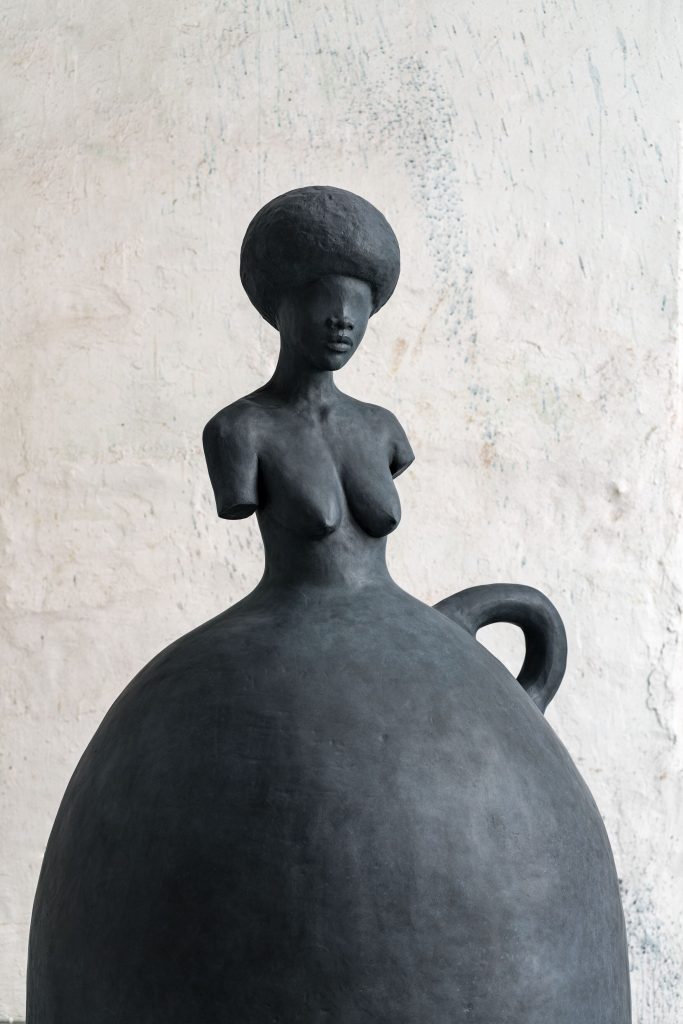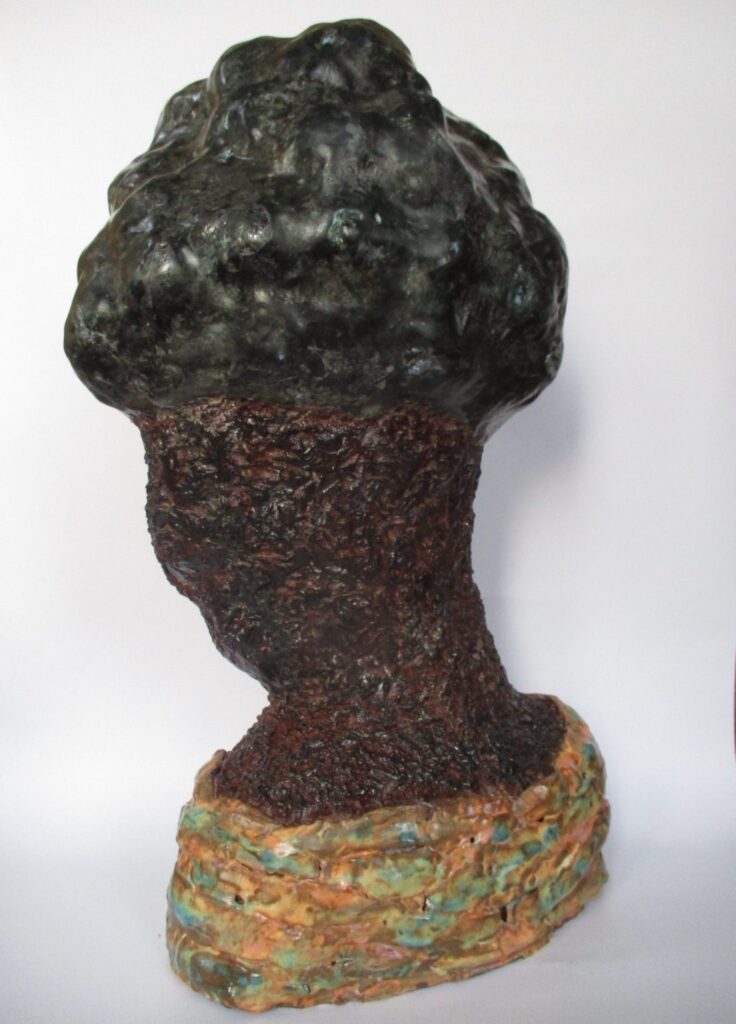Contemporary artist and sculptor “creates organic and abstract objects using clay and found or repurposed materials.” She incorporates personal experiences, her wonderful process of sketching forms, employing her intuition and then with clay in hand, mold bodies that are both abstract and figural, that draw from the feminine divine and abstraction. This episode includes a conversation with the artist.

Resources for this podcast episode include Gina Lee Robbins website, Brooklyn Museum of Art, Metropolitan Museum of Art, Guggenheim Museum, writer Casey Lesser and ceramist Emmanuel Cooper, the artist Simone Leigh.
Script: Today I want to draw you into a two works by the contemporary sculptor Gina Lee Robbins; multiple views of three dimensional, ceramic, figures, one a self-portrait. The first titled “Figure,” a contemplation of the artist’s body through biomorphic forms–biomorphic are forms that “while abstract evoke the human body.” Atop two tree trunk thick legs is a round pot belly shaped body; the indication of two arms is abstracted by two holes carved into the fullest part of the belly; the head is for me the most interesting aspect of the work; a thin tube-shaped form extends from the top of the globe shaped body, slinky and loose, it is hollowed out with no indication of a face; like one, large open eye taking in the world through one lens, every one of its senses; taste, smell, sight tunnels through this opening; think elephant trunk, the surface of the skin is a somewhat, roughly pitted, textured surface–you can sense the hands of the artist, imagine the gesticulated indentation of the artist’s fingers as she shapes the figure, this image of self.
Gina Lee Robbins “creates organic and abstract objects using clay and found or repurposed materials. She works intuitively” For me this is what captures my attention, draws my curiosity; her process to allow herself the space to work with materials, her hands in clay surrender to the process of molding and these are her words, “until something other worldly yet viscerally familiar almost breathes before me.” There are per formative qualities working with clay and why I want to explore Gina’s works as an entry point.
Gina shared that the work “Figure” “is a very personal piece to me. It’s a self-portrait, of sorts. It began as many of my sculptures do, as an abstract form in my sketchbook. I often make quick drawings of things that I experience on the periphery…forms that I catch in the corner of my eye, or in the background that require a refocus to make meaning of them. I’m interested in that initial perception, or misperception, really. This form began as one of those sketches, but as I worked on the sculpture, it became more organic, even figurative.” In the act of creating, Gina the artist brings to the work her ruminations of her role as a mother, “the complex emotional experience of the transitions that motherhood requires.” She says pointedly, “much of the gesture and detail of “Figure” is addressing her feelings and transition of her two sons as they approach manhood, one is 18, the other 20.” In this context, I, the viewer, experience the work “Figure” with far more depth. The tube-shaped head with the wide opening, just grabs me. I consider my shared experiences with Gina as a mother to two children, a son and daughter, both adults, and interpret the wide solitary opening of the “head” like a vacuum, the tension of wanting to pull or suck my children to me, as they reverberate towards their own paths.
Gina brings this engaging feminine perspective to sculpture, creating interesting and challenging forms, embracing new ways to reconfigure the body. Through clay, the messy physicality of the material, the artist brings the female form to life, at least for me, in surprising ways. In her approach to the three-dimensions in sculpture, Gina re-imagines what the human figure could be. There is no surface decoration–nothing but pure form remains. And yet there is a deep and horizon-wide set of emotions modeled through her hands into the work, as she describes, the force of motherhood, her ruminations around her role in the lives of her sons; her engagement with form through her intuitive drawings and rethinking the relationship between form and meaning.
One connection I made and later learned is also an inspiration for Gina in her work, is the similarities between her creation “Figure” and prehistoric female figures. Typically, they are crafted from clay or carved from stone, the iconic Venus of Willendorf is an example; the body parts, breasts, bellies, buttocks are emphasized; some denote carved or painted lines and patterns suggesting scarification, clothing, jewelry. Most of these figurines must be supported to stand in upright positions, and they are small enough to be carried. They are often referred to idols and goddesses, although there is a debate over the use of these terms since little is known about the objects’ function and meaning. (Brooklyn Museum) There is also a modern aesthetic in Gina’s abstract figure through the biomorphic or organic forms.
In her artistic practice Gina also uses paintings as inspiration for her ceramic sculptures. She shared, “This started when I tried to render some of my friend’s abstracted figures from their paintings in 3D. I did three to four of those, none of which ultimately resembled the originals. The work “Slow Setting,” was part of this series. It was an attempt to build a three-dimensional representation of a Paul Klee portrait. the 1939 work “Nordic Artist,” to which I was especially drawn. The resulting figure resembles the painting only slightly in gesture. I transformed the figure by adding something of an elaborate coiffure, by pressing the clay out from the inside.”
First let me describe Gina’s object of art “Slow Setting” It is a bust of a portrait. We see head, neck atop a patterned base. The face is blank appears like a silhouette; no defining features, just slight curves indicating nose and chin. What is striking is the hair, as Gina describes; an elaborate coiffure, gesticulating curls and swirls like ocean waves. I spent some time comparing the painting to Gina’s interpretation in the three dimensional. Nordic Artist, by the 20th century modernist Paul Klee is a portrait painting comprised of a face and neck, painted vivid red against a blue and green background. The facial features, eyes, nose are flat, fractured forms, the brushstrokes expressive, almost child-like.
Artists like Gina who make ceramic objects from the shaping of clay have “steadily contributed to the art world for centuries. From prehistoric pottery to ancient Greek amphoras, from the rise of porcelain in Asia and Europe to the Arts and Crafts movement in England and the U.S., ceramic traditions have long fascinated artists and infiltrated their practices.” (Casey Lesser) Women artists arguably championed the medium; elevating the traditions of functional pottery thrown on a wheel, to fine art. Female sculptors like the 20th century British born Ruth Duckworth, considered a “great original, pioneering her own path within ceramics, brilliantly exploring the idea of the figure, the vessel and the more abstract form,” (Emmanuel Cooper). She “shaped new ways of thinking about ceramics in the second half of the 20th century. Approaching clay as a sculptor rather than a potter, she brought an aesthetic rigor to her refined vessel forms, figurative sculptures and installations, which range in size from a few inches to breathtakingly large, site-specific commissions.” (from the ceramist Emmanuel Cooper)
The 1998 work, “Untitled,” part of the Metropolitan Museum of Art collection is a smooth ceramic work, relatively small 38x23x5 inches of abstract forms. It is a wall sculpture or relief, in pure white that combines geometric and organic forms. Framed within rectangular shaped forms or planes, there are circles and subtly curved forms, the relief suggests the female body. What fascinates me is within this object of art, what translates from her hands into the clay is what the artist claims as “inherent sensuality,” this “inherent sensuality” stems from universal connections to nature and biology.
The Black female contemporary artist Simone Leigh sculpts from clay monumental figures of Black female bodies. Drawing from variety of sources, including the art of ancient Egypt, traditional West African adobe structures, American domestic architecture, and craft, Leigh explores ideas about the Black female body, race, beauty, and community. Her sculptures suggest the presence of figures—powerful Black women crowned by Afros. “The way you understand a sculpture is by relating it to your own body, so you feel its edges and its presence in space by that relationship. When I think about a young black child relating to that sculpture, it’s very exciting for me.” Leigh’s forms of Black women appear to meld with jugs and conical structures. In her work, “Jug,” the body is shaped like a conical jug, as Leigh describes, “reminiscent of early 20th century West African sculpture. There is the African American form of the jug, the upper torso and then there is the rather contemporary representation of the woman herself and her face and the way her hair is drawn.
Let’s for a moment allow what Simone Leigh says about sculpture to sink in–“The way you understand a sculpture is by relating it to your own body, so you feel its edges and its presence in space by that relationship.” This gives me chills as I let her words, those words wash over me. I think for me as the spectator, as the viewer, it helps me to engage with sculpture more directly; visually linking my own body with the work. Leigh opens us up to the black woman and her experience; Ruth Duckworth, British born, who came to the United States in mid-20th century offers us a way to see the body purely through form, both geometric and organic. I think Gina follows along this path incorporating personal experiences, her wonderful process of sketching forms, employing her intuition and then with clay in hand, mold bodies that are both abstract and figural, that draw from the feminine divine and abstraction, even from male artists like Paul Klee and her artistic voyage towards the three dimension. In these women artists we see the female figure as something solid instead of something fragile and weak.
In this episode, I am highlighting a narrow view of Gina’s work, she is so prolific in her exploration and creation of sculptural objects of clay, and also found and reclaimed materials. She is largely self taught and has been working with ceramics for over 25 years. She resides outside of Chicago where is a visual and teaching artist. Join me now in a conversation with the artist, Gina Lee Robbins.




